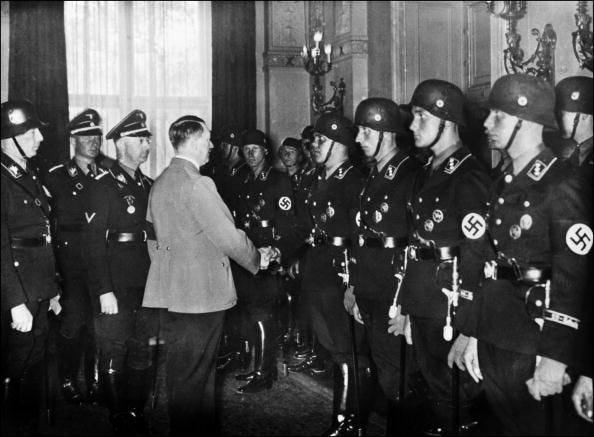Was Hugo Boss A Nazi?
I recently came across an article that claimed that Hugo Boss designed the iconic black Nazi uniforms, and I honestly couldn’t believe my eyes. As I dug in, I realized that this is a common misconception; even though he produced clothes for the German armed forces, Waffen-SS, and the armed wing of the SS, he never designed the clothes himself. Karl Diebitsch (a senior SS officer and an artist) collaborated with Walter Heck (a graphic designer) to create the infamous uniforms. Neither of these men worked or had any connection with Hugo Boss.

In 1931, he joined the National Socialist Party. He claimed that he only did so because he believed that the party would be doing something about the rising unemployment plaguing Germany. However, he later said that he would never have received so many orders if he wasn’t a member, which helped him stay financially afloat during the war. We must understand that even though he claims he only joined the party for business reasons, he was never aggressive or hostile towards the Nazi Party, and there are reports of him even believing in the cause. In 1933, Hugo Boss advertised that they made uniforms for the SS, Hitler Youth, and the Brownshirts (the paramilitary wing for the Nazi Party).

There have even been claims of him using forced laborers in his factories to produce the clothes for the parties. During the Second World War, he had employed around 140 forced laborers (most of them were women) and 40 French prisoners of war. It’s, however, interesting to note that his company was the third-largest in the city of Metzingten, where a total of 1241 forced laborers worked. There has been no indication about his company leading in the sector. He was just one of the producers among many who received such orders to manufacture uniforms.
How different were these forced laborers treated compared to the prisoners at the concentration camps?
When it came to their accommodation, the men got stationed at ‘sheds’ in the company’s camp. The consensus was that they were elementary in comparison to the situation of the prisoners at the concentration camps.
On the other hand, the women supposedly lived with the local families around the factory. Thankfully to the prisoners, there was an improvement in this situation at the start of 1943, when the major clothing companies from Metzingen built a dedicated camp for the ‘Eastern European’ workers. The purpose of this dedicated space was to differentiate between the residents and the forced laborers. Still, it is essential to note that this was only in response to law by the Government of Württemberg that mandated the same on August 21st, 1943.
But even here, they always faced low food supplies and an even lower hygiene level due to the financial difficulties faced by this newly constructed camp. A better counterpart than the other business owners, Hugo Boss at least tried to ease this situation by giving the women workers meals at the company canteen. There has also been evidence that the company tried to improve the food shortage situation for all the forced laborers. Even coming to the wages, Hugo Boss paid his employees a fairer salary than they would have seen under some other owner, especially during the war. Then again, although it was considerably ‘fairer,’ the compensation was still too low for them to have any actual ‘buying power.
It is surprising that many forced laborers even expressed somewhat positive views on Hugo Boss as a person, and many even considered him half decent. Still, the company did have its fair share of ardent National Socialists who treated the workers horrifically (especially women) and even threatened them with concentration camps on occasion. Although Hugo Boss was not involved in these incidents and was not directly involved in his workers’ ‘harsh’ treatments, he did not do much to stop it or improve the situation. My opinion is that although he was not a harsh, stone-cold Nazi, he was still a party member and was, therefore, ‘involved’ in all its wrongdoings. He might have been considerably ‘better,’ but that just wasn’t enough.
What happened after the occupation of Metzingen by the Allied Troops?
Like all others, Hugo F. Boss went through the process of ‘denazification .’ The verdict said that he was’ incriminated’ (the second-highest punishment the Reutlingen Chamber of Commerce Precinct) and fined a high amount of 10,000 marks. The designer benefitted financially from the Nazi rule, and his excellent relationship with many of them did not help his cause. However, this time, he appealed against this sentence and was classified as a ‘follower’ (someone who abided by the party without getting involved in its politics). This verdict came as no surprise because that was the verdict apparently in many such cases.
What happened to the company, and how did it build its legacy today?
Two years after the verdict, on August 9th, 1948, Hugo Ferdinand Boss succumbed to an untreatable infection caused by a tooth abscess. After this death, Eugen Holy, Hugo Boss’s son-in-law, took over the business. During this time, Hugo Boss started selling suits, and by the end of the 1960s, the company’s turnover was a whopping 3.5 million Deutschmarks. Around 1969, Jochen and Uwe Holy, Eugen’s brothers, took over the company and shaped it into what it is today.
